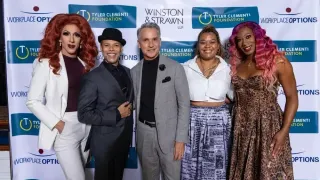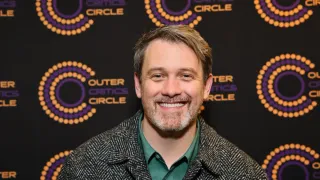
3 hours ago
JoJo Siwa Reflects on Emotional Beginnings With Chris Hughes on 'Celebrity Big Brother'
READ TIME: 3 MIN.
JoJo Siwa, the performer and outspoken LGBTQ+ advocate, made headlines this week after becoming visibly emotional while returning to the Celebrity Big Brother set—scene of her first connection with her now-partner, Chris Hughes. Siwa was a guest panelist on ITV2’s Late and Live, where she shared her feelings about revisiting the place where their story began earlier in 2025 .
In a segment with host Will Best, Siwa described being overwhelmed by memories: “I texted Christopher, and I said ‘the body remembers more than the brain does’… it’s very emotional.” She recalled vivid moments and butterflies, saying, “I had memories pop up that I have completely forgotten about… it’s weird,” underscoring the powerful emotional impact of her time in the Celebrity Big Brother house .
Siwa and Hughes, who first met as contestants on Celebrity Big Brother earlier in 2025, initially described their bond as a “soulmate friendship.” The relationship became a topic of speculation, especially given Siwa’s public breakup with former partner Kath Ebbs shortly after the show’s finale . Both Siwa and Hughes later confirmed their connection had evolved beyond friendship, with Siwa stating, “It’s been a beautiful development, a beautiful connection, and I’m absolutely head over heels for him—and he’s the same way” . The couple made their relationship official in June, following several weeks of social media attention and “soft launches” .
Siwa reflected candidly on the unique pressures of beginning a relationship in the public eye, saying, “You’re in this house for a long time. You fall in love with this man, and you think ‘Oh I really hope my parents are liking this. Not only do I hope my parents are proud of me, which is what everyone wanted, but also I have this whole relationship that I started in here’” .
JoJo Siwa has been a visible advocate for LGBTQ+ youth since coming out publicly in 2021, often discussing her own journey on platforms such as Instagram and during her time on television . She has stated she prefers to identify as “queer,” emphasizing the importance of authenticity and evolving self-understanding . As she marked the start of Pride Month in June, Siwa posted: “What I have learned over the last 22 years is that pride is all about love, acceptance, and celebration. No matter who you are or what you are, you are you, you are beautiful, and you are perfect” .
The visibility of Siwa’s relationship with Hughes, particularly as it developed on mainstream reality television, has been significant for LGBTQ+ representation. Her openness about the emotional complexities—both joyful and challenging—of navigating love and identity in front of millions has resonated with fans and advocates alike .
Family played a notable part in the couple’s journey. Siwa shared that her family’s enthusiastic support after she left the Big Brother house was a source of happiness: “After the fact when I got out and my family was like ‘we really cannot wait to meet Chris.’ That made me feel so happy… his brother and my mum were talking the entire time” .
The couple’s relationship has drawn broader attention from both British and international media, with Hughes’ father even speculating about a possible marriage before the end of the year . For many LGBTQ+ viewers, the authentic and affirming way in which Siwa and Hughes have shared their story stands as a reminder of the importance of visible, supportive relationships in challenging stereotypes and encouraging acceptance.






